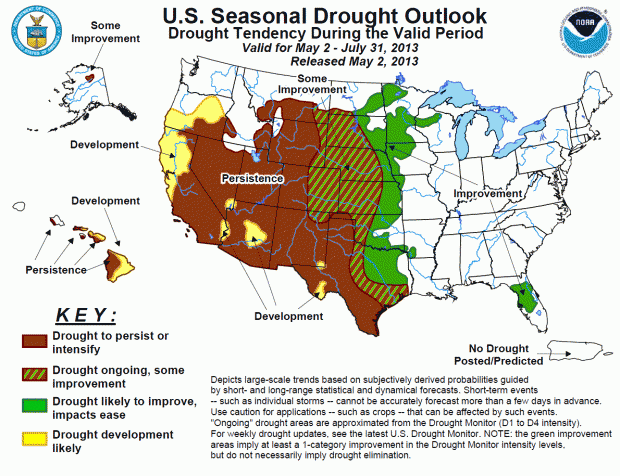This Week in Drought: Conditions May Improve, But Crops in Danger

Map by NOAA
The latest NOAA drought outlook shows possible improvement for a larger part of the state than in the past forecast.
More of Texas could begin to recover from the drought in the coming months, but it may not be soon enough to save many of the state’s crops.
The three-month outlook from the National Oceanic and Atmospheric Administration (NOAA) Climate Prediction Center, released Thursday, shows a larger portion of the state possibly improving than in a previous forecast, with much of East Texas listed as “likely to improve” or having “some improvement,” however the drought is forecast to “persist or intensify” in the Western half of the state.
Though the US Drought Monitor Map released Thursday shows no difference in how much of the state is experiencing drought this week, it does show less of Texas under the two most severe drought stages. Much of this exceptional drought is in deep South Texas, where it is taking a toll on crops.

Rod Santa Ana / AgriLife Communications
South Texas crops, like cotton, could face $100 million losses this year.
According to the Texas A&M AgriLife Extension Service, this year may be worse than 2006, when extensive drought and lack of available water from the Rio Grande river caused $50 million in crop losses. This year losses in row crops like cotton, corn and grain sorghum could cost $100 million, according to AgriLife’s Dr. Luis Ribera.
“In 2006, Valley dryland growers lost 75 percent of their cotton acreage, 86 percent of their corn acreage and 43 percent of their grain sorghum acres to drought,” Ribera said in an AgriLife release. “At 2006 market prices, losses exceeded $50 million. But market prices have more than doubled in some cases, so losses could be much higher this year.
Even with as much as six inches of rain falling in the region last week, Ribera says it may have been too little, too late.
“It’s just not looking good. We need a big rain event this summer to turn this drought around and start filling our reservoirs [in the area].”
Other crops are suffering in the drought, too. AgriLife Extension state forage specialist Dr. Larry Redmon says in the report that much of the state’s warm-season grass pastures have not yet recovered from the 2010 drought. Redmon says the continued drought and cooler than average temperatures both contributed to the slow recovery of those crops. Add to that late-season freezes in Central Texas and the Panhandle, and you could be looking at another year of agricultural losses in Texas.
